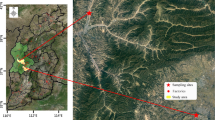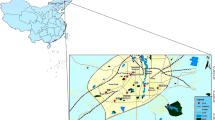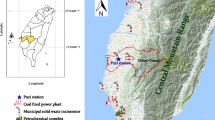Abstract
The fine particulate matter samples for 24 h were carried out at the Environment Monitoring Station (EMS) and Shandong Jianzhu University (SJU) sites during 2010 in Jinan City, China. Eight water-soluble ion species were analyzed by ion chromatography, while organic carbon (OC) and elemental carbon (EC) were determined with the IMPROVE thermal optical reflectance method, and 20 inorganic elements were measured by inductively coupled plasma-atomic emission spectrometer and inductively coupled plasma-mass spectroscopy. The annual average mass concentration of PM2.5 was 168.85 μg m−3 at EMS and 148.67 μg m−3 at SJU. The coefficient of divergence was 0.14, 0.19, 0.23, and 0.23 in spring, summer, fall, and winter, respectively, indicating that there was no obvious spatial difference at the two sampling sites. The highest PM2.5, OC, and OC/EC ratio were in winter because of the enhanced emissions from coal combustion for heating and poor atmospheric dispersion. By the method of enrichment factors, the 20 inorganic elements were divided into three types owing to their sources. Al, Si, and Ti were mainly contributed by crustal sources. Na, Mg, P, K, Ca, V, Cr, Mn, Fe, Co, Ni, Ba, and Sr were from both natural emissions and anthropogenic sources. Cu, Zn, Pb, and Sn mainly originated from anthropogenic sources such as vehicular exhaust and industrial emission. Chemical mass closure calculation estimated that SO4 2− was the largest contributor and explained 29.66 % of PM2.5 mass at EMS, while 31.64 % was at SJU. The organic matter, crustal matter, and NO3 –, respectively, accounted for 15.12, 12.87, and 13.77 % to PM2.5 at EMS, while it accounted for 13.46, 13.96, and 14.93 % at SJU, respectively. By the positive matrix factorization analysis, the coal combustion and biomass burning, secondary sulfate, soil dust, secondary nitrate, and vehicle emissions were identified as the major emission sources.







Similar content being viewed by others
References
Baldwin AT, Schmelz EA, Ohnmeiss TE (1994) Wound-induced changes in root and shoot jasmonic acid pools correlate with induced nicotine synthesis in Nicotiana sylvestris Spegazzini and Comes. J Chem Ecol 20(8):2139–2157
Cao JJ, Lee SC, Ho KF, Zou SC, Fung K, Li Y, Watson JG, Chow JC (2004) Spatial and seasonal variations of atmospheric organic carbon and elemental carbon in Pearl River Delta Region, China. Atmos Environ 38(27):4447–4456
Cao JJ, Wu F, Chow JC, Lee SC, Li Y, Chen SW, An ZS, Fung KK, Watson JG, Zhu CS, Liu SX (2005) Characterization and source apportionment of atmospheric organic and elemental carbon during fall and winter of 2003 in Xi’an, China. Atmos Chem Phys 5:3127–3137
Cao JJ, Lee SC, Chow JC, Watson JG, Ho KF, Zhang RJ, Jin ZD, Shen ZX, Chen GC, Kang YM, Zou LZ, Zhang LZ, Qi Sh, Dai MH, Cheng Y, Hu K (2007) Spatial and seasonal distributions of carbonaceous aerosols over China. J Geophys Res 112 (D22), doi:10.1029/2006JD008205.
Castro LM, Pio CA, Harrison RM, Smith DJT (1999) Carbonaceous aerosol in urban and rural European atmospheres: estimation of secondary organic carbon concentrations. Atmos Environ 33(17):2771–2781
Chan YC, Simpson RW, Mctainsh GH, Vowle PD (1997) Characterization of chemical species in PM2.5 and PM10 aerosols in Brisbane, Australia. Atmos Environ 31(22):2061–2080
Cheng YF, Berghof M, Garland RM, Wiedensohler A, Wehner B, Müller T, Su H, Zhang YH, Achter P, Nowak A, Pöschl U, Zhu T, Hu M, Meng LM (2009) Influence of soot mixing state on aerosol light absorption and single scattering albedo during air mass 15 aging at a polluted regional site in northeastern China. J Geophys Res 114(D2):D00G10, doi:10.1029/2008JD010883
Chio C, Cheng M, Wang C (2004) Source apportionment to PM in different air quality conditions for Taichung urban and coastal areas, Taiwan. Atmos Environ 38(39):6893–6905
Chow JC, Watson JG, Lu ZQ, Lowenthal DH, Frazier CA, Solomon PA, Thuillier RH, Magliano K (1996) Descriptive analysis of PM2.5 and PM10 at regionally representative locations during SJVAQS/AUSPEX. Atmos Environ 30(12):2079–2112
Chow JC, Watson JG, Crow D, Lowenthal DH, Merrifield T (2001) Comparison of IMPROVE and NIOSH carbon measurements. Aerosol Sci Technol 34(1):23–34
Chow JC, Watson JG, Chen LWA, Arnott WP, Moosmüller H (2004) Equivalence of elemental carbon by thermal/optical reflectance and transmittance with different temperature protocols. Environ Sci Technol 38(16):4414–4422
Chow JC, Watson JG, Louie PK, Chen LW, Sin D (2005) Comparison of PM2.5 carbon measurement methods in Hong Kong, China. Environ Pollut 137(2):334–344
Christoforou CS, Salmon LG, Hannigan MP, Solomon PA, Cass GR (2000) Trends in fine particle concentration and chemical composition in southern California. J Air Waste Manag Assoc 50(1):43–53
Dan M, Zhuang GS, Li XX (2004) The characteristics of carbonaceous species and their sources in PM2.5 in Beijing. Atmos Environ 38(21):3443–3452
Dockery DW, Stone PH (2007) Cardiovascular risks from fine particulate air pollution. N Engl J Med 356:511–513
Duan JC, Tan JH, Cheng DX, Bi XH, Deng WJ, Sheng GY, Fu JM, Wong MH (2007) Sources and characteristics of carbonaceous aerosol in two largest cities in Pearl River Delta Region, China. Atmos Environ 41(14):2895–2903
Duan J, Tan J (2013) Atmospheric heavy metals and arsenic in China: situation, sources and control policies. Atmos Environ 74:93–101
Gao J, Wang J, Cheng SH, Xue LK, Hz Y, Hou LJ, Jiang YQ, Wang WX (2007) Number concentration and size distribution of submicron particles in Jinan urban area: characteristics in summer and winter. J Environ Sci 19(12):1466–1473
Gu JX, Bai ZP, Li AX, Wu LP, Xie YY, Lei WF, Dong HY, Zhag X (2011) Chemical composition of PM2.5 during winter in Tianjin, China. Particuology 9(3):215–221
Guo S, Hu M, Wang ZB, Wang ZB, Slanina J, Zhao YL (2010) Size-resolved aerosol water-soluble ionic compositions in the summer of Beijing: implication of regional f secondary ormation. Atmos Chem Phys 10:947–959
Harrison RM (2004) Key pollutants—airborne particles. Sci Total Environ 334–335:3–8
He KB, Yang FM, Ma YL, Ma YL, Zhang Q, Yao XH, Chan CK, Cadle S, Chan T, Mulawa P (2001) The characteristics of PM2.5 in Beijing, China. Atmos Environ 35(29):4959–4970
Huang XF, He LY, Hu M, Zhang YH (2006) Annual variation of particulate organic compounds in PM2.5 in the urban atmosphere of Beijing. Atmos Environ 40(14):2449–2458
Ianniello A, Spataro F, Esposito G, Allegrini I, Hu M, Zhu T (2011) Chemical characteristics of inorganic ammonium salts in PM2.5 in the atmosphere of Beijing (China). Atmos Chem Phys 11:10803–10822
Kim HS, Huh JB, Hopke PK, Holsen TM, Yi SM (2007) Characteristics of the major chemical constituents of PM2.5 and smog events in Seoul, Korea in 2003 and 2004. Atmos Environ 41(32):6762–6770
Kong SF, Lu B, Bai ZP, Zhao XY, Han B, Li ZY, Ji YQ, XuYH LY, Jiang H (2011) Potential threat of heavy metals in re-suspended dusts on building surfaces in oilfield city. Atmos Environ 45(25):4192–4204
Lee E, Chan CK, Paatero P (1999) Application of Positive matrix factorization in source apportionment of particle pollutants in HongKong. Atmos Environ 33:3201–3212
Li XR, Wang LL, Wang YS, Wen TX, Yang YJ, Zhao YN, Wang YF (2012) Chemical composition and size distribution of airborne particulate matters in Beijing during the 2008 Olympics. Atmos Environ 50:278–286
Liu W, Wang Y, Russell A, Edgerton LES (2005) Atmospheric aerosol over two urban–rural pairs in the southeastern United States: chemical composition and possible sources. Atmos Environ 39:4453–4470
Menon S, Hansen J, Nazarenko L, Luo YF (2002) Climate effects of black carbon aerosols in China and India. Science 297(5590):2250–2253
Norris G, YoungPong SN, Koenig JQ, Lrson TV, Sheppard L, Stout JW (1999) An association between fine particles and asthma emergency department visits for children in Seattle. Environ Health Perspect 107(6):489–493
Ostro B, Broadwin R, Green S, Feng WY, Lipsett M (2006) Fine particulate air pollution and mortality in nine California counties: results from CALFINE. Environ Health Perspect 114(1):29–33
Park SS, Kim YJ (2004) PM2.5 particles and size-segregated ionic species measured during fall season in three urban sites in Korea. Atmos Environ 38(10):1459–1471
Paatero P, Tapper U (1994) Positive matrix factorization: a non-negative factor model with optimal utilization of error estimates of data values. Environmetrics 5:111–126
Paatero, P (2004) User’s guide for positive matrix factorization programs PMF2 and PMF3, part 1: tutorial.
Raman RS, Hopke PK (2007) Source apportionment of fine particles utilizing partially speciated carbonaceous aerosol data at two rural locations in New York state. Atmos Environ 41:7923–7939
Reiss R, Anderson EL, Cross CE, Hidy DH, Clellan RM, Moolgavkar S (2007) Evidence of health impacts of sulfate- and nitrate-containing particles in ambient air. Inhal Toxicol 19(5):419–449
Schwartz J, Dockery DW, Neas LM (1996) Is daily mortality associated specifically with fine particles? J Air Waste Manag Assoc 46(10):927–939
Song Y, Zhang YH, Xie SD, Zeng LM, Zheng M, Salmon LG, Shao M, Slanina S (2006) Source apportionment of PM2.5 in Beijing by positive matrix factorization. Atmos Environ 40(8):1526–1537
Sun YL, Zhuang GS, Wang Y, Han L, Guo J, Dan M, Zhang WJ, Wang ZF, Hao ZP (2004) The air-borne particulate pollution in Beijing—concentration, composition, distribution and sources. Atmos Environ 38(35):5991–6004
Sutton MA, Place CJ, Eager M, Fowler D, Smith RI (1995) Assessment of the magnitude of ammonia emissions in the United Kingdom. Atmos Environ 29(12):1393–1411
Tao J, Cao JJ, Zhang RJ, Zhu LH, Zhang T, Shi S, Chan CY (2012) Reconstructed light extinction coefficients using chemical compositions of PM2.5 in winter in urban Guangzhou, China. Adv Atmos Sci 29(2):359–368
Turpin BJ, Huntzicker JJ (1995) Identification of secondary aerosol episodes and quantification of primary and secondary organic aerosol concentrations during SCAQS. Atmos Environ 29(23):3527–3544
Tsitouridou R, Samara C (1993) First results of acidic and alkaline constituents determination in air particulates of Thessaloniki, Greece. Atmos Environ, Part B Urban Atmos 27(3):313–319
Vedal S (1997) Critical review: ambient particles and health: lines that divide. J Air Waste Manag Assoc 47(5):551–581
Walker JT, Whitall DR, Robarge W, Paerl HW (2004) Ambient ammonia and ammonium aerosol across a region of variable ammonia emission density. Atmos Environ 38(9):1235–1246
Wang M, Hu M (2000) Sea salt source contribution to the aerosol in Qingdao seashore area. J Environ Sci-China 21(5):83–85
Wang Q, Shao M, Zhang Y, Wei Y, Hu M, Guo S (2009) Source apportionment of fine organic aerosols in Beijing. Atmos Chem Phys 9:8573–8585
Wang Y, Zhuang GS, Tang AH, Yuan H, Sun YL, Chen S, Zheng AH (2005) The ion chemistry and the source of PM2.5 aerosol in Beijing. Atmos Environ 39(21):3771–3784
Watson JG (2002) Critical review discussion. Visibility: science and regulation. J Air Waste Manag Assoc 52:628–713
Wongphatarakul V, Friedlander SK, Pinto JP (1998) A comparative study of PM2.5 ambient aerosol chemical databases. Environ Sci Technol 32(24):3926–3934
Yang FM, He KB, Ma YL, Zhnag Q (2004) Characterization of mass balance of PM2.5 chemical speciation in Beijing. Environ Chem-China 23(3):326–333
Yao XH, Chan CK, Fang M, Cadle S, Chan T, Mulawa P, He K, Ye B (2002) The water-soluble ionic composition of PM2.5 in Shanghai and Beijing, China. Atmos Environ 36(26):4223–4234
Yao XH, Lau APS, Fang M, Chan CK, Hu M (2003) Size distributions and formation of ionic species in atmospheric particulate pollutants in Beijing, China: 1-inorganic ions. Atmos Environ 37(21):2991–3000
Zhang Z, Friedlander SK (2000) A comparative study of chemical databases for fine particle Chinese aerosols. Environ Sci Technol 34(22):4687–4694
Zheng M, Salmon LG, Schauer JJ, Zeng L, Kiang CS, Zhang Y, Cass GR (2005) Seasonal trends in PM2.5 source contributions in Beijing, China. Atmos Environ 39:3967–3976
Zhou JM, Zhang RJ, Cao JJ, Chow JC, Watson JG (2012) Carbonaceous and ionic components of atmospheric fine particles in Beijing and their impact on atmospheric visibility. Aerosol Air Qual Res 12:492–502
Acknowledgments
This study was projected by Tianjin Science and Technology Development Commission (11JCYBJC05200), Ministry of Environmental Protection of China (2010467007), and Jinan Science and Technology Development Commission (201101090).
Author information
Authors and Affiliations
Corresponding author
Rights and permissions
About this article
Cite this article
Gu, J., Du, S., Han, D. et al. Major chemical compositions, possible sources, and mass closure analysis of PM2.5 in Jinan, China. Air Qual Atmos Health 7, 251–262 (2014). https://doi.org/10.1007/s11869-013-0232-9
Received:
Accepted:
Published:
Issue Date:
DOI: https://doi.org/10.1007/s11869-013-0232-9




